A soft, tender, enriched bread made with sourdough: this sourdough brioche is the recipe you were looking for. Made with melted butter and with no need to knead, this brioche is the perfect breakfast bread.

If you're looking for more sourdough recipes that are perfect for sandwiches, you need to try this soft sourdough sandwich bread! And for more no-knead bread, this parmesan onion focaccia is an almost zero effort deliciousness.
What’s a brioche?
A brioche is a bread made with plenty of eggs, milk and butter. It is what’s called an enriched bread, as a brioche is usually more rich in flavor than a bread made with only salt, water, yeast and flour. So if you ever wondered why a brioche is more expensive than normal bread, the ingredients it has is what makes the higher price.
The ingredients also give this bread a soft crumb, super tender and insanely tasty. The egg wash the dough receives just before baking gives an amazing golden-brown crust, and the taste the butter leaves in your mouth will make you want to have another slice.
It’s similar to challah bread, with the biggest difference being that brioche uses butter, while challah has oil in its dough.
Why make a brioche with sourdough?
Although there are a few that disagree, a brioche is often called the tastiest bread in the world. But what can make a brioche even better (besides chocolate - chocolate makes everything better)?
Make it using a sourdough starter! Adding sourdough to my brioche recipe was a game changer for me. Now, I have the best of 2 worlds: the rich buttery brioche taste, and all the new flavors a sourdough dough can develop.
Bread made with sourdough is also said to be easier to digest than bread fermented with commercial yeast. That’s because wild yeast breaks down gluten differently than commercial yeast. So if after eating bread with gluten you feel bloated, try a sourdough one.
Baking schedule
This is a schedule that works for me and my starter. Don’t follow it blindly: every starter is different. Also, the dough is temperature-responsive, so it may behave differently in the summer/winter/the country you live in.
Day 1
- 12 PM: Feed sourdough starter.
- 6 PM: Make the dough.
- 6 PM - 10 PM: bulk fermentation + stretch and fold
- 10 PM: cold fermentation (16h).
Day 2
- 2 PM: Let dough at room temperature for 1 hour.
- 3 PM: Shaping + Proofing
- 5 PM: Baking.
How to make it
Ready to start the best brioche you’ll ever eat? If you have any doubts, watch the video at the end of the post for a better visual explanation! And feel free to leave your questions in the comments.
Day 1
Feed sourdough starter. Feed it 6 to 10 hours before you plan to start the dough. It should double, be bubbly and pass the float test for this recipe. Try not using before its peak. Also, you’ll need a 100% hydration starter for this recipe.

Put the dough together. This is a no-knead dough, so don’t worry: it’s quite simple to make and asks for melted butter. Mix the dry ingredients, the add room-temperature milk, butter, eggs and sourdough starter. Mix until dough is formed and no dry spots remain. Cover with a damp towel or plastic/beeswax wrap.
Bulk fermentation. Let dough rise outside your fridge for 4 hours in a warm spot. Perform a stretch and fold every 30 minutes. This is a high hydration dough, so it will always be a bit sticky to work with. You can wet your hands before handling the dough to make it easier, if you’re having any trouble with it. Always cover the dough between stretch and folds, and cover it well before placing inside the fridge.

Cold fermentation. Again, cover dough really well: you don’t want it to develop a dry skin. I usually make a 16 to 24 hours cold fermentation, but you can choose between 10 to 48 hours. The longer it is, the more complex the final taste will be.
Day 2
Room temperature. Take dough out of the fridge and leave it resting at room temperature for 1 hour.
Dividing and shaping. Flour lightly the surface you’ll use to work the dough. Divide the dough into 4 equal pieces. Shape each piece, folding the dough over itself until getting a tight ball. Arrange shaped dough into a loaf pan lined with parchment paper.
Proofing. Let the dough rise for 2 to 4 hours more. Remember to cover loosely with plastic/beeswax wrap and leave it in a warm spot. When ready, it will be almost twice its initial size, and will feel soft and light to the touch. Mine is usually good after 2 hours. Careful not to overproof, or the dough might collapse.
Preheating and egg wash. Preheat your oven for 20 minutes before baking. In a small bowl, separate one egg yolk for the egg wash. With a cooking brush, cover brioche lightly with the egg wash just before baking.
Baking. Bake at 350°F for 45 minutes, or until brioche has a deep golden-brown color, sound hollow when tapped and reaches an internal central temperature of 190°F. If it’s browning too much on the top, cover with foil paper and continue baking. Careful to not underbake, as it’s very easy, as the top will brown very quick.
Cooling. Remove from pan and leave brioche loaf cooling on a cooling rack. Don’t slice until it has fully cooled, or at least for a full hour after baking, as bread is still cooking inside. Slicing it while hot may cause it to have a gummy, slightly unbaked texture.

Tips for success
- Make sure all the ingredients are room temperature. That’s always important when baking bread, specially when doing it with sourdough. Cold ingredients may slow down fermentation and ever make your starter dormant.
- Don’t add hot butter. Melt it, but make sure butter is lukewarm and not boiling before adding it to de dough. Leaving it resting 2 to 3 minutes after melting should be enough.
- Use a 100% hydration starter. That’s one fed with equal amounts of water and flour.
- Always leave dough resting in a warm spot. Cold spots will slow down the fermentation, and the recipe will take longer. A warm spot may be one near your heater, on the top of your fridge, inside your oven (even better if it has a proofing function), or even close to the stove if you’re using it.
- Wait for brioche to fully cool before slicing it! That can make a huge difference in the final result, both in texture and flavor.
- Make sure your starter is active before making the dough. An inactive starter will strongly compromise this recipe.
How does a no-knead dough works?
For a bread to achieve an airy light and chewy texture, it needs to develop gluten. That’s why we knead the dough: to develop all the gluten we need for baking the most satisfying bread loaf.
So how does a no-knead bread recipe works?
Well, in a no-knead bread, it’s all about enzymes. Flour is full of enzymes that helps gluten formation. All you have to do is mix together all ingredients and let them rest enough before baking, so the enzymes, with the help of fermentation activity, can develop enough gluten.
To check if there’s enough gluten formation in your dough, always check windowpane. For this recipe, you should have a very elastic windowpane by the end of cold fermentation. You can see that in the video by the end of the post.

Why my brioche feels dry?
If your brioche feels dry, a few things could have happened while making it.
- Don’t add more flour than the recipe asks for. Adding more flour can make a drier brioche bread. Have you measured correctly the flour if using measurement cups? Have you added more flour to the dough to make it easier to handle it when stretching and folding/shaping?
- Careful not to overproof. Overproofing may give you a tough and dry brioche. Only let your dough proof until it doubles.
- Store it properly. Sourdough brioche keeps as good as fresh for at least 3 days if stored correctly. Store it in an airtight container, away from sunlight and at room temperature. If left in contact with air or inside your fridge, it will get dry.
What to make with brioche dough
Although I’m presenting you with a brioche loaf in this post, this dough is also amazing for:
Hamburger buns. Divide dough in 8 to 10 pieces. Shape each one into a tight ball, folding the dough over itself. Flatten the ball with your hand, and place each shaped dough into a lined baking sheet. Let them rise until them almost double, are light and look fluffy, for about 1 hour and 30 minutes. Preheat oven and bake for 20 to 25 minutes.
Hot dog buns. Same as hamburger buns. Follow my brioche hot dog buns instructions for shaping and baking the dough.
Cinnamon rolls. Open the dough and fill it with cinnamon sugar. Let rolls rise for another 1 hour and 30 minutes or until they look puffy. Follow my blood orange cinnamon rolls instructions for shaping, filling, slicing and baking.
Pull-apart brioche rolls. Follow my whole wheat dinner rolls instructions for shaping and baking the dough. Let them rise for about 1 hour and 30 minutes on the second rise, or until dough looks puffy.
French toast. Try my sourdough French toast recipe using sourdough brioche. You’ll never have a tastier French toast!
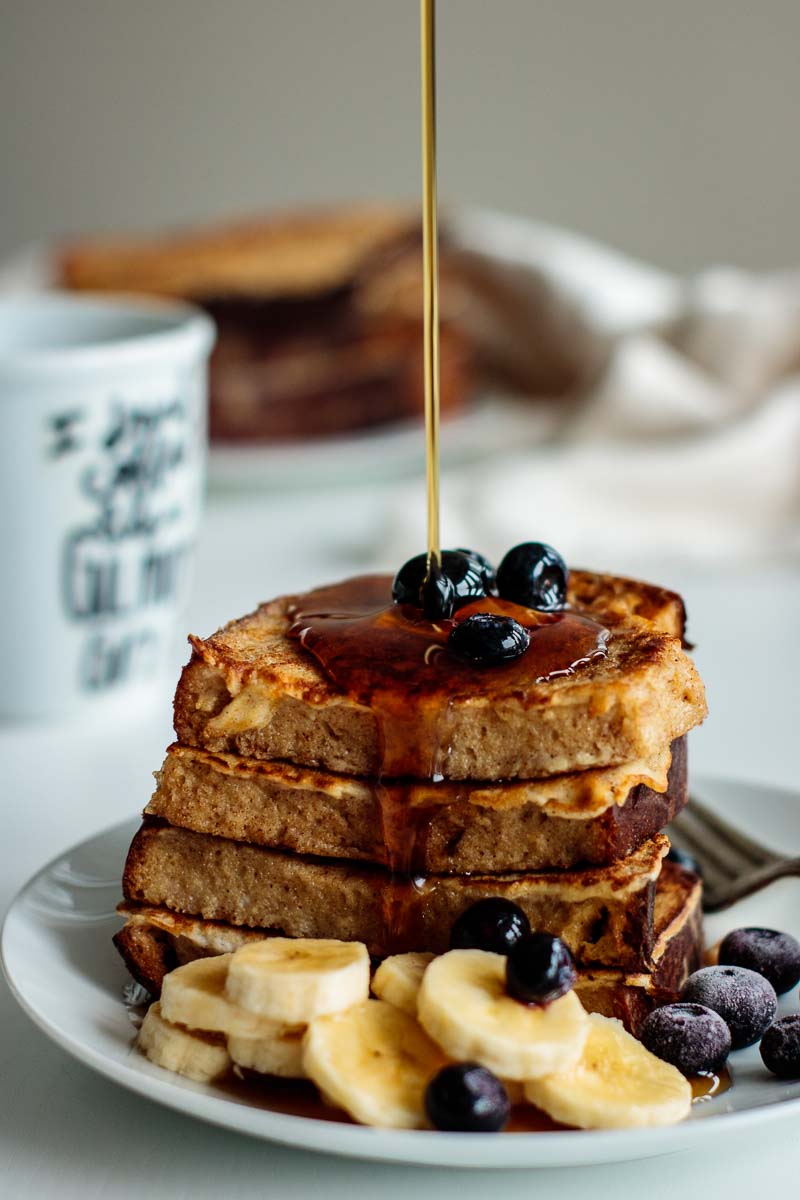
Have another use for brioche dough? Let me know in the comments!
Storing and freezing
A brioche usually stays fresh for 24 hours in an airtight container at room temperature. This sourdough brioche feels fresh from 3 to 5 days. Always store in an airtight container at room temperature. Storing bread inside your fridge may cause it to dry out.
Sourdough brioche can also be frozen for up to 2 months. Let brioche cool completely before freezing. Wrap the loaf tightly in plastic wrap and aluminum foil, or use a freezer-safe bag, pushing all the air out before sealing and placing on your freezer.
More Sourdough Recipes
Sourdough Bagels
English Muffins made with sourdough
Sourdough Discard Pancakes
The Best Sourdough Tortillas
📖 Recipe
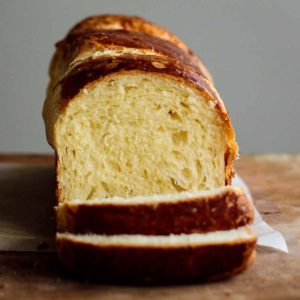
No-Knead Sourdough Brioche
Ingredients
- 3 cups all-purpose or bread flour 370g
- 3 tablespoon sugar 36g
- 1 ½ teaspoon salt 7g
- ¼ cup milk room temperature (60ml)
- 8 tablespoon butter melted (110g)
- 3 eggs room temperature
- ½ cup sourdough starter 120g
- 1 egg yolk for egg wash
Instructions
- Day 1: Feed your sourdough starter 6 to 10 hours before making the dough.
- In a large bowl, mix the dry ingredients: flour, sugar and salt.
- Add melted butter, milk, eggs and sourdough starter. Start mixing it with a spoon, then switch to your hands and knead it only until the dough is formed and no dry spots remain. The dough will feel sticky. Cover with a damp towel or plastic/beeswax wrap.
- Let dough rise for 4 hours in a warm spot. Perform a stretch and fold every 30 minutes. You can wet your hands before handling the dough to make it easier. Always cover the dough between stretch and folds. It’s ready for cold fermentation when it has risen half its size.
- Place dough inside fridge, covering it with plastic/beeswax wrap so it won’t develop a skin. Choose between 10 to 48 hours of cold fermentation.
- Day 2: Take dough out of the fridge and leave it resting at room temperature for 1 hour.
- Line a loaf pan with parchment paper.
- Flour lightly the surface you’ll use to work the dough. Divide the dough into 4 equal pieces. Shape each piece, folding the dough over itself until getting a tight ball. Arrange shaped dough into the lined loaf pan.
- Let shaped dough rise for 2 to 4 hours more in a warm spot, covering it loosely with plastic/beeswax wrap. It will be ready when dough reaches almost twice its initial size and feels soft and light to the touch.
- Preheat oven for 20 minutes before baking, 350°F.
- In a small bowl, separate one egg yolk for the egg wash. With a brush, cover brioche lightly with the egg wash just before baking.
- Bake at 350°F for 45 minutes, or until brioche has a deep golden-brown color, sound hollow when tapped and reaches an internal central temperature of 190°F. If it’s browning too much on the top, cover with foil paper and continue baking.
- Remove from pan and leave brioche loaf cooling on a cooling rack for 1 to 3 hours.

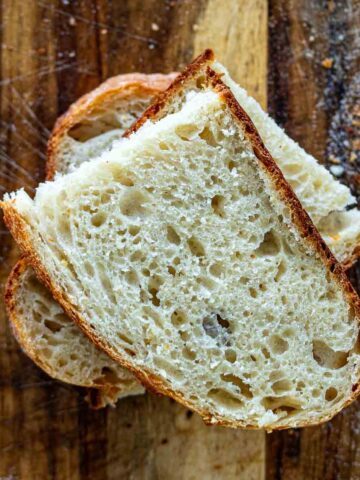
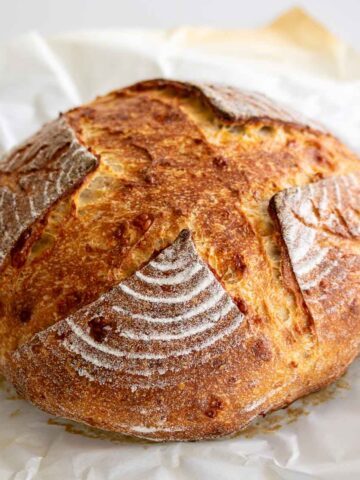
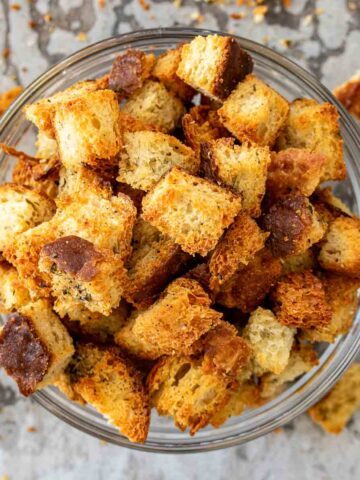
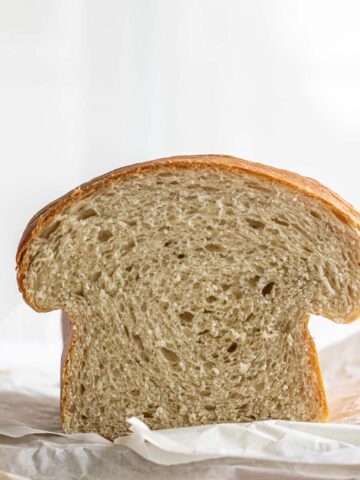
Khalil
I've made this recipe a few times with very good, consistent results. The last time I replaced the butter with coconut oil, and the sugar with honey. It was amazing!
Every time I've made it, I've used starter that was days past its peak (I store my starter in the refrigerator) with absolutely no loss of fermentation capacity. I've always gotten great flavor and rise.
MIR
Easy to follow recipe. Delicious results. The family enjoyed the fresh brioche very much. Thank you!